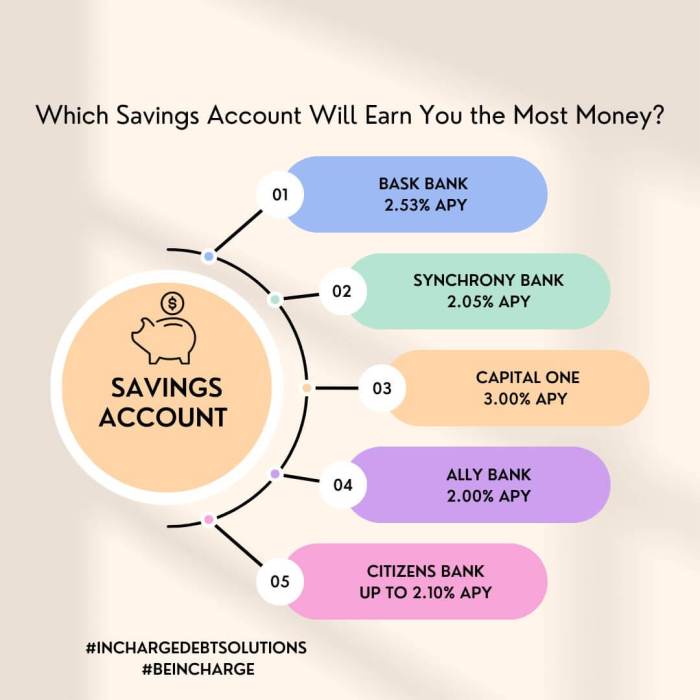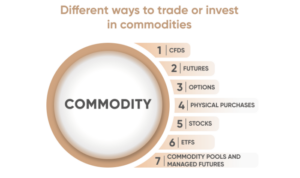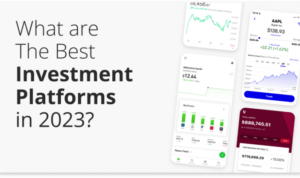Diving into the world of Savings account options, get ready to explore the ins and outs of different account types, interest rates, minimum balance requirements, and fees. This guide will equip you with the knowledge needed to make informed decisions about your savings.
From high-yield to traditional accounts, we’ve got you covered with all the details you need to know to maximize your savings potential.
Types of Savings Accounts
When it comes to saving money, there are several types of savings accounts you can choose from. Each type has its own set of features, benefits, and limitations, so it’s important to understand the differences to make the best decision for your financial goals.
High-Yield Savings Accounts
A high-yield savings account offers a higher interest rate compared to traditional savings accounts. This means your money can grow faster over time. These accounts are typically offered by online banks and often have no monthly fees.
Traditional Savings Accounts
Traditional savings accounts are offered by brick-and-mortar banks and credit unions. They usually have lower interest rates than high-yield accounts but may offer more convenience in terms of access to ATMs and in-person customer service.
Money Market Accounts
Money market accounts combine features of savings and checking accounts. They often have higher interest rates than traditional savings accounts and may come with check-writing privileges. These accounts are ideal for those who want to earn higher interest while still having easy access to their funds.
Interest Rates and APY

When it comes to savings accounts, interest rates and APY play a crucial role in determining how much your money can grow over time. Let’s dive into what these terms mean and how they can impact your savings.
Definition of Interest Rates and APY
Interest rates represent the percentage of your deposit that the bank pays you for keeping your money in a savings account. On the other hand, APY (Annual Percentage Yield) is the total amount of interest you earn on your savings in one year, taking into account compounding interest.
Impact of Interest Rates and APY
Higher interest rates and APY can significantly boost your savings over time. By earning more interest on your deposits, you can watch your money grow faster and reach your financial goals sooner. On the flip side, lower interest rates mean slower growth for your savings.
Tips to Find Competitive Interest Rates and APY
1. Compare rates: Look for banks or credit unions that offer competitive interest rates on savings accounts.
2. Consider online banks: Online banks often offer higher interest rates and APY compared to traditional brick-and-mortar banks.
3. Check for promotions: Some financial institutions run promotions with increased interest rates for a limited time. Keep an eye out for these opportunities.
4. Look for high-yield savings accounts: These accounts typically offer higher interest rates and APY, allowing you to maximize your savings potential.
5. Keep an eye on fees: Make sure to consider any fees associated with the savings account, as they can eat into your interest earnings.
Minimum Balance Requirements
Meeting the minimum balance requirements is crucial when it comes to managing your savings account. Let’s dive into the details of what this entails and why it’s important.
Variation in Minimum Balance Requirements
Different savings accounts have varying minimum balance requirements, which can range from as low as $0 to several thousand dollars. Some accounts may require you to maintain a certain balance at all times, while others may only have a minimum balance requirement to open the account.
- Basic Savings Account: Typically require a low minimum balance, such as $25 or $100, to open the account.
- High-Yield Savings Account: These accounts may have higher minimum balance requirements, often starting at $500 or more, to earn the higher interest rates offered.
- Online Savings Account: Many online savings accounts have no minimum balance requirements, making them accessible to a wider range of savers.
Importance of Meeting Minimum Balance Requirements
Meeting the minimum balance requirements is essential to avoid monthly maintenance fees or penalties. Additionally, some accounts offer higher interest rates or other benefits when you maintain a certain balance. By meeting these requirements, you can maximize the potential earnings on your savings.
Examples of Accounts with Low or No Minimum Balance Requirements
- Ally Bank Online Savings Account: No minimum balance requirement and no monthly maintenance fees.
- Discover Online Savings Account: No minimum balance requirement and no fees.
- Chase Savings Account: $300 minimum daily balance to waive the monthly service fee.
Fees and Charges
When it comes to savings accounts, it’s important to be aware of the various fees and charges that may apply. These fees can impact your overall savings goals, so it’s crucial to understand them and find ways to minimize them.
Common Fees Associated with Savings Accounts
- Monthly Maintenance Fees: Some financial institutions charge a monthly fee for maintaining a savings account. This fee can range from a few dollars to more significant amounts, depending on the bank.
- Overdraft Fees: If you withdraw more money than you have in your savings account, you may incur overdraft fees. These fees can be costly and add up quickly if you’re not careful.
Ways to Minimize Fees and Charges on Savings Accounts
- Maintain the Minimum Balance: Many banks waive monthly maintenance fees if you keep a minimum balance in your savings account. Be sure to check the requirements with your financial institution.
- Opt for Fee-Free Accounts: Some banks offer savings accounts with no monthly maintenance fees or overdraft fees. Consider opening an account with these institutions to avoid unnecessary charges.
Comparing Fee Structures Across Different Financial Institutions
| Financial Institution | Monthly Maintenance Fee | Overdraft Fee |
|---|---|---|
| Bank A | $5 | $35 |
| Bank B | $0 | $25 |
| Bank C | $3 | $30 |






